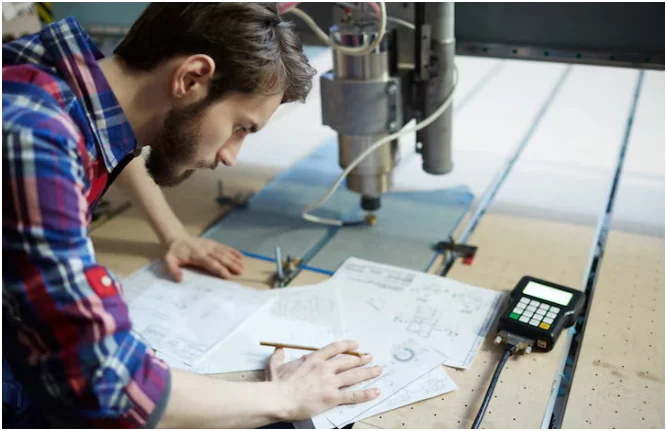The surface finish in machining is crucial for performance, durability, and aesthetics, especially in industries like aerospace and medical devices. Key machining parameters like cutting speed, feed rate, and tool geometry significantly influence surface quality. By optimizing these factors, manufacturers can reduce waste and improve product quality.
What are Machining Parameters?
Machining parameters are the controllable variables that define how a cutting tool interacts with the workpiece during material removal processes. These parameters form the foundation of any machining operation and directly influence productivity, tool life, and surface quality.
The primary machining parameters include cutting speed (the velocity at which the cutting tool moves relative to the workpiece), feed rate (how fast the workpiece advances into the tool), and depth of cut (how much material is removed in a single pass). Secondary parameters encompass tool geometry, material properties, and environmental factors like coolant application.
Optimizing these parameters requires balancing multiple objectives. Aggressive parameters may increase productivity but could compromise surface finish. Conservative settings might produce excellent surface quality while reducing efficiency. The art of machining lies in finding the sweet spot that meets all requirements.
Key Machining Parameters
Cutting Speed
Cutting speed represents the rate at which the cutting edge moves past the workpiece surface, typically measured in surface feet per minute (SFM) or meters per minute. This parameter significantly influences heat generation, tool wear, and ultimately surface finish quality.
Higher cutting speeds generally improve surface finish by reducing the time the tool spends in contact with any single point on the workpiece. This minimizes heat buildup and reduces the likelihood of material adhesion to the cutting edge. However, excessive speeds can cause tool wear, chatter, or thermal damage that degrades surface quality.
The optimal cutting speed varies by material. Aluminum and other non-ferrous metals often perform well at high speeds, while hardened steels require more conservative approaches to prevent rapid tool degradation.
Feed Rate
Feed rate determines how quickly the workpiece advances into the cutting tool, directly affecting the thickness of material removed per revolution or stroke. This parameter has perhaps the most visible impact on surface finish, as it controls the theoretical surface roughness pattern.
Lower feed rates typically produce smoother surfaces by creating thinner chips and reducing the scallop height between adjacent tool passes. However, extremely low feed rates can cause rubbing rather than cutting, leading to work hardening and poor surface quality.
The relationship between feed rate and surface finish follows predictable patterns, but optimal settings depend on tool geometry, workpiece material, and required surface specifications. Fine finishing operations often employ feed rates significantly lower than roughing passes.
Depth of Cut
Depth of cut refers to the thickness of material removed in a single pass, influencing cutting forces, heat generation, and surface integrity. While depth of cut has less direct impact on surface finish than cutting speed or feed rate, it affects other parameters that ultimately influence surface quality.
Shallow depths of cut reduce cutting forces and minimize deflection in both the workpiece and cutting tool. This improved rigidity leads to better surface finish and dimensional accuracy. Deep cuts generate higher forces that can cause chatter, vibration, or tool deflection—all detrimental to surface quality.
Manufacturing operations like those involving heavy machinery transport (such as moving equipment with a lowboy gooseneck trailer) require components with specific surface finish requirements that often necessitate carefully controlled depth of cut parameters.
Tool Material and Geometry
Tool material selection and geometric design profoundly impact surface finish capabilities. Carbide tools offer excellent wear resistance and can maintain sharp cutting edges longer than high-speed steel alternatives. Ceramic and diamond tools provide even better performance for specific applications but require careful parameter selection.
Tool geometry affects chip formation, cutting forces, and heat distribution. Sharp cutting edges with appropriate clearance angles minimize material deformation and produce superior surface finishes. Nose radius, rake angle, and relief angles must be optimized for the specific material and finishing requirements.
Coated tools extend performance by reducing friction and heat generation while maintaining sharp cutting edges longer. Modern coatings like TiAlN or diamond-like carbon can significantly improve surface finish consistency throughout the tool’s operational life.
Effects on Surface Finish
Each machining parameter creates distinct effects on the final surface texture and quality. Understanding these relationships enables precise control over the finishing process.
Cutting speed affects surface finish through its influence on temperature and material flow. Optimal speeds promote clean shearing action that leaves smooth surfaces, while inappropriate speeds cause material smearing, built-up edge formation, or thermal damage. The resulting surface may appear torn, rough, or contain embedded particles.
Feed rate directly determines the theoretical surface roughness through the geometric relationship between tool path and surface generation. Higher feed rates create deeper tool marks and increased roughness values. The actual surface quality also depends on material properties and how cleanly the material separates during cutting.
Depth of cut influences surface finish indirectly through its effect on cutting forces and system stability. Heavy cuts can overwhelm the machine’s rigidity, causing vibration that transfers to the workpiece surface as chatter marks. Optimal depths balance productivity with surface quality requirements.
Tool condition plays a crucial role in surface finish consistency. Sharp tools produce clean cuts with minimal material deformation, while worn tools crush and tear material, creating rough surfaces. Regular tool monitoring prevents gradual surface quality degradation.
The Role of Coolant and Lubrication
Proper coolant and lubrication systems significantly enhance surface finish quality by managing heat, removing chips, and reducing friction between tool and workpiece. These systems create conditions that promote clean cutting action and prevent material adhesion.
Coolant application helps maintain consistent temperatures throughout the cutting zone, preventing thermal expansion that could affect dimensional accuracy and surface quality. Flood cooling, mist systems, and high-pressure coolant delivery each offer specific advantages depending on the application.
Lubrication reduces friction between the cutting tool and workpiece, minimizing the forces that can cause surface deformation. Modern cutting fluids combine cooling and lubricating properties with excellent chip removal characteristics that keep the cutting zone clean.
The choice between wet and dry machining depends on the specific application, environmental considerations, and required surface quality. Some materials and processes actually perform better without coolant, while others absolutely require fluid application for acceptable results.
Advanced Machining Techniques
High-Speed Machining
High-speed machining (HSM) techniques revolutionize surface finish capabilities by operating at cutting speeds well above conventional ranges. These processes take advantage of the relationship between cutting speed and surface quality to achieve superior finishes with increased productivity.
HSM requires specialized equipment with high-speed spindles, rigid construction, and advanced control systems. The combination of high speeds and light cuts produces excellent surface finishes while removing material efficiently. Tool selection becomes critical, as conventional tools may not survive the demanding operating conditions.
The benefits of HSM extend beyond surface finish to include reduced cutting forces, improved tool life (when properly implemented), and the ability to machine complex geometries with exceptional accuracy. However, successful implementation requires careful attention to all system components.
Precision Grinding
Precision grinding represents the ultimate in surface finish control, capable of achieving mirror-like surfaces with extremely tight tolerances. Grinding operations remove very small amounts of material per pass, allowing precise control over surface texture and dimensional accuracy.
Modern grinding systems incorporate advanced wheel technology, precision spindles, and sophisticated control systems that maintain consistent surface quality. Ceramic and superabrasive wheels enable grinding of materials that would be difficult to machine conventionally while producing superior surface finishes.
The grinding process parameters—wheel speed, feed rate, depth of cut, and dressing frequency—require careful optimization for each application. Proper coolant application becomes even more critical in grinding due to the high specific energy involved in the process.
Optimizing Your Machining Process
Achieving consistent, high-quality surface finishes requires a systematic approach to parameter optimization. Start by establishing baseline parameters based on material properties and required surface specifications, then make incremental adjustments while monitoring results.
Tool selection forms the foundation of any successful finishing operation. Choose tools with appropriate geometry, material, and coatings for the specific application. Maintain sharp cutting edges through proper tool management and replacement schedules.
Machine condition significantly impacts surface finish capabilities. Ensure spindle bearings are in good condition, eliminate sources of vibration, and maintain proper alignment between all system components. Regular maintenance prevents gradual degradation in surface quality.
Process monitoring helps identify trends before they affect part quality. Track surface roughness measurements, tool wear patterns, and dimensional accuracy to establish optimal parameter ranges. This data enables proactive adjustments that maintain consistent results.
Conclusion
Now that we have explored the importance of surface quality in machining processes, it is clear that it plays a crucial role in ensuring the overall quality and functionality of machined parts.


